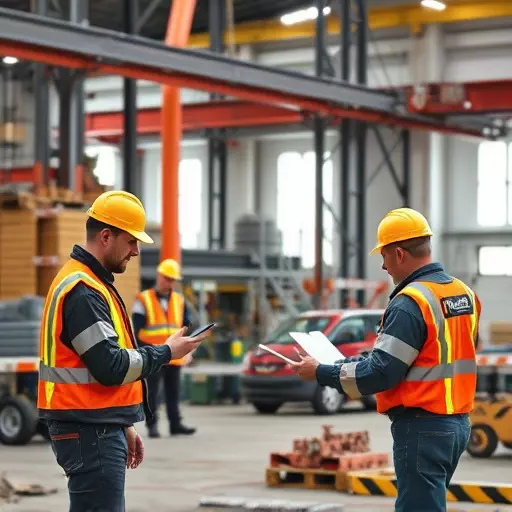Hazard assessment techniques, crucial for robust safety programs, involve systematic analyses of workplace environments and tasks to identify risks. Specialized safety training by industry experts ensures these processes align with best practices tailored to specific sectors. This enables effective safety training curriculum development covering observation, risk analysis, data-driven assessments, and engineering controls. By fostering a culture of proactive safety management through customized curricula, organizations minimize accident risks, boost operational efficiency, and enhance employee confidence in handling hazardous situations. Regular audits and feedback ensure continuous improvement, aligning with best practices and regulatory standards for a safer work environment.
“Uncovering the essence of safety management, this article delves into the multifaceted world of hazard assessment techniques. From understanding the foundational concepts to exploring specialized safety training tailored by industry, each segment offers a strategic approach. We dissect the importance of curriculum development in creating effective safety training programs. Furthermore, we guide through the implementation and evaluation of hazard assessment strategies, ensuring organizations remain proactive in mitigating risks. Discover how these techniques foster a culture of safety across diverse sectors.”
- Understanding Hazard Assessment Techniques
- Specialized Safety Training by Industry
- Curriculum Development for Effective Safety Training
- Implementing and Evaluating Hazard Assessment Strategies
Understanding Hazard Assessment Techniques

Hazard assessment techniques are crucial components of any comprehensive safety program. These methods involve systematic analyses of workplace environments and tasks to identify potential risks and hazards that could harm employees, customers, or other stakeholders. By employing specialized safety training by industry experts, organizations can ensure their hazard assessment processes align with best practices tailored to specific sectors. Such training facilitates the development of effective safety training curriculum that covers various techniques, from observation and risk analysis to data-driven assessments and engineering controls.
Understanding these techniques empowers employees to recognize hazards proactively, implement preventive measures, and respond appropriately in case of emergencies. This proactive approach not only enhances overall safety but also fosters a culture where everyone takes responsibility for their well-being and that of their colleagues. Effective hazard assessment techniques are the bedrock upon which robust health and safety management systems are built, ensuring that workplaces remain safe, efficient, and compliant with regulatory standards.
Specialized Safety Training by Industry

The importance of specialized safety training by industry cannot be overstated in the context of hazard assessment techniques. Each industry has its unique set of risks and challenges, necessitating tailored safety training programs. These customized curricula are designed to equip workers with the knowledge and skills required to identify, mitigate, and respond to potential hazards specific to their sector. Safety training curriculum development involves a thorough understanding of industry-specific regulations, recognized risk factors, and best practices for accident prevention.
Specialized safety training by industry goes beyond general health and safety protocols. It incorporates practical exercises, case studies, and scenario-based learning that directly correlate with the workplace environment. By aligning hazard assessment techniques with industry-focused training, organizations can foster a culture of proactive safety management. This proactive approach not only minimizes accident risks but also enhances operational efficiency and employee morale through increased confidence in handling hazardous situations.
Curriculum Development for Effective Safety Training

Curriculum development plays a pivotal role in shaping effective safety training programs tailored to specific industries and their unique hazard assessment techniques. A well-structured curriculum ensures that employees receive specialized safety training, addressing the inherent risks associated with their respective sectors. By integrating industry-specific knowledge, practical exercises, and interactive learning methods, the curriculum becomes a powerful tool for empowering workers with the skills needed to identify, mitigate, and respond to potential hazards.
Safety training educators must collaborate closely with industry experts to create relevant content that aligns with current best practices and regulatory standards. Regular updates to the curriculum are essential to incorporate emerging safety protocols, new technologies, and evolving hazard assessment methodologies. This dynamic approach ensures that safety training remains pertinent, comprehensive, and capable of equipping employees with the latest tools for safeguarding their well-being in the workplace.
Implementing and Evaluating Hazard Assessment Strategies

Implementing and evaluating hazard assessment strategies is a critical aspect of any organization’s commitment to specialized safety training by industry. Effective hazard assessment techniques involve a systematic process of identifying, analyzing, and prioritizing potential risks within a workplace. By integrating these methods into a comprehensive safety training curriculum development, businesses can create tailored programs that address the unique challenges faced in various industries.
This involves conducting thorough risk assessments, employing advanced data analytics to identify trends and patterns, and utilizing cutting-edge technology for more accurate predictions. Once implemented, regular audits and feedback mechanisms are essential to evaluate the effectiveness of these strategies. This iterative process ensures continuous improvement, aligning with industry best practices and regulatory standards, ultimately fostering a safer work environment.


